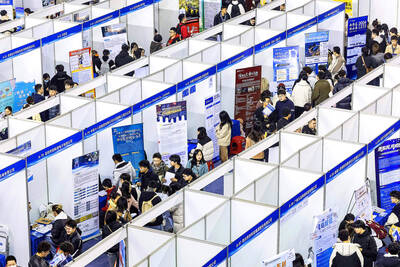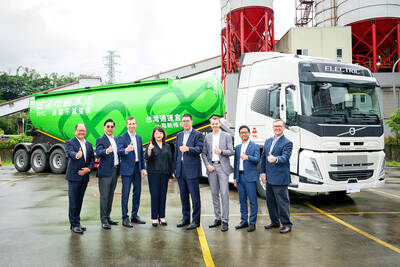Metals capped off a tumultuous year dominated by supply squeezes, China’s property-led economic slowdown and a global energy crisis that hints at more disruptions to come.
Last year saw copper hitting a record as the COVID-19 pandemic roiled supply and demand, but tin was the star performer as base metals marched higher.
Gold bulls were ultimately left disappointed even as inflation raged, while iron ore suffered a boom-to-bust collapse from above US$200 a tonne to below US$100 on China’s waning appetite.

Photo: Reuters
The contours of this year’s other major drivers are already visible. Dangerously low inventories was a theme across metals that are expected to carry into next year — especially if the global economy continues to improve.
Beijing’s stimulus measures might put a floor under China’s steel woes, while US Federal Reserve tightening and stubborn inflation is a headwind elsewhere. Energy and the climate agenda should dominate aluminum in particular.
“Base metals performed outstandingly well this year, which is not surprising, as they effectively made up ground that was lost during 2020,” Mine Life Pty founding director Gavin Wendt said. “Next year should see a continuation of overall positive demand, but with greater price volatility as the supply side recovers.”
Tin does not normally receive much attention, but it was the big winner and perhaps a poster child for metals last yera. Prices nearly doubled from a year earlier, with an electronics boom fueling demand and COVID-19 disruptions crimping supply.
The LMEX index of six London-traded metals is heading for a seventh quarterly gain.
Iron ore was among the big losers last year, with the apparent end to China’s era of frenzied construction dragging on prices, but authorities are expected to implement fiscal stimulus and monetary policies to counter this year’s sharp slowdown. The manufacturing data for last month have already showed that upward momentum is intact.
Gold finishes the year a little below where it started, after a meandering year as investors turned to riskier assets, including energy and industrial commodities.
Fed tightening threatens more headwinds. Investors largely expect the Fed to raise interest rates three times this year, with some market participants expecting a hike as early March.
For now, soaring energy costs in Europe also continue to dominate the supply side for base metals. In its latest impact on production, Alcoa Corp said this week that it would halt a Spanish plant for two years on high energy costs.
Aluminum has risen more than 40 percent this year, and banks forecast a deeper deficit next year as the world’s decarbonization push starts to tighten output worldwide.
On Friday, base metals were mostly lower.
Gold for February delivery rose US$14.50 to US$1,828.60 an ounce, increasing 0.93 percent from a week earlier.
Silver for March delivery rose US$0.29 to US$23.35 an ounce, up 1.79 percent on the week, while March copper rose US0.07 to US$4.46 a pound, posting a weekly gain of 1.59 percent.
Additional reporting by AP

Stephen Garrett, a 27-year-old graduate student, always thought he would study in China, but first the country’s restrictive COVID-19 policies made it nearly impossible and now he has other concerns. The cost is one deterrent, but Garrett is more worried about restrictions on academic freedom and the personal risk of being stranded in China. He is not alone. Only about 700 American students are studying at Chinese universities, down from a peak of nearly 25,000 a decade ago, while there are nearly 300,000 Chinese students at US schools. Some young Americans are discouraged from investing their time in China by what they see

Taiwan Transport and Storage Corp (TTS, 台灣通運倉儲) yesterday unveiled its first electric tractor unit — manufactured by Volvo Trucks — in a ceremony in Taipei, and said the unit would soon be used to transport cement produced by Taiwan Cement Corp (TCC, 台灣水泥). Both TTS and TCC belong to TCC International Holdings Ltd (台泥國際集團). With the electric tractor unit, the Taipei-based cement firm would become the first in Taiwan to use electric vehicles to transport construction materials. TTS chairman Koo Kung-yi (辜公怡), Volvo Trucks vice president of sales and marketing Johan Selven, TCC president Roman Cheng (程耀輝) and Taikoo Motors Group

MAJOR DROP: CEO Tim Cook, who is visiting Hanoi, pledged the firm was committed to Vietnam after its smartphone shipments declined 9.6% annually in the first quarter Apple Inc yesterday said it would increase spending on suppliers in Vietnam, a key production hub, as CEO Tim Cook arrived in the country for a two-day visit. The iPhone maker announced the news in a statement on its Web site, but gave no details of how much it would spend or where the money would go. Cook is expected to meet programmers, content creators and students during his visit, online newspaper VnExpress reported. The visit comes as US President Joe Biden’s administration seeks to ramp up Vietnam’s role in the global tech supply chain to reduce the US’ dependence on China. Images on

New apartments in Taiwan’s major cities are getting smaller, while old apartments are increasingly occupied by older people, many of whom live alone, government data showed. The phenomenon has to do with sharpening unaffordable property prices and an aging population, property brokers said. Apartments with one bedroom that are two years old or older have gained a noticeable presence in the nation’s six special municipalities as well as Hsinchu county and city in the past five years, Evertrust Rehouse Co (永慶房產集團) found, citing data from the government’s real-price transaction platform. In Taipei, apartments with one bedroom accounted for 19 percent of deals last